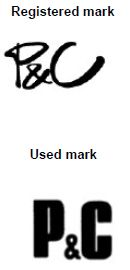In a late 2014 decision the Federal Administrative Court provided further guidance on how the design of a trademark can be altered without losing the rights attached to it. The decision shows that it may be advisable not to change the letter type or font of the mark in a significant way if the mark was registered in a certain typeface.
Facts
Clothing company Peek & Cloppenburg initiated opposition proceedings against registration of the word mark PD&C in Class 25 on the basis of its own prior international word and figurative mark P&C. The defendant claimed non-use of the prior mark. Peek & Cloppenburg in turn submitted evidence to prove use of its trademark. However, the defendant claimed that the opposing trademark had not been used in a manner that preserved the rights attached to it.
Under Article 12(1) of the Trademark Act, in order to preserve the rights attached to a trademark, the rights holder must have used the mark during the five years prior to a non-use claim. As stated in Article 11(2) of the act, use in a form that does not differ significantly from the registered form also constitutes trademark use and therefore preserves trademark rights.
Evidence for the use of a trademark may take the form of documents (eg, invoices and delivery notes) and inspection objects (eg, sample labels, packaging, catalogues and brochures). All documents must refer to the relevant time period before the non-use opposition. In the case at hand, much of the submitted evidence showed Peek and Cloppenburg's mark in a way that differed from the registration:

Decision
The court's decision discussed the way in which a trademark can be used without losing the rights attached to it. The basis for use must be the original registration. Deviations from the registration's specification (eg, by graphical redesign of the mark or the addition of further elements) can be made while preserving the mark, provided that such deviations are not significant. The court held that a deviation is insignificant if it concerns some of the trademark's elements without affecting the mark's distinctiveness as such. It further noted that the more distinctive the trademark is, the greater the scope of the rights holder to adapt the mark's design – for example, to change it according to market habits.
Dealing with the question of whether the evidence in this case showed the opposing trademark in a form that differed significantly from the registration, the court assessed the letter sequence "P&C" with different typefaces. The court held that the registered trademark was based on a modern-curved font type, which contributed to its distinctiveness. However, the representation of "P&C" as actually used was not based on this font type. According to the court, the design as used did not bring to mind the registered trademark, but rather appeared to be another sign. The court saw no reason to attribute a high level of distinctiveness to the registered mark, such that it would have allowed the rights holder to deviate further from the registered form.
As such, the court did not consider the submitted evidencing documents showing "P&C" with a different typeface to be prima facie evidence of trademark use.
Comment
Following this decision, it is apparent that the scope of a rights holder to change the design of a trademark (ie, its typeface) is limited where the changed element is considered to contribute to the mark's distinctiveness.
Previously published by ILO
The content of this article is intended to provide a general guide to the subject matter. Specialist advice should be sought about your specific circumstances.


